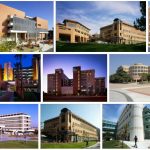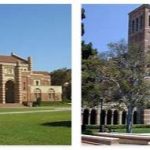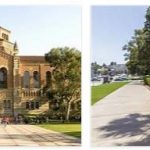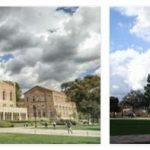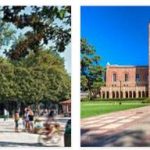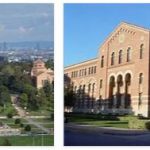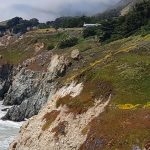Population: 37,691.912 thousand people (2011)
Area: 423970.0 sq. km
California is a US state located on the west coast of the Pacific Ocean. Bounded to the north by the state of Oregon, to the southeast by the state of Arizona, to the east by the state of Nevada, and to the south bounded by the territory of Mexico.
The state holds the first place in the United States in terms of population. Large cities such as Los Angeles (the state’s largest city), San Diego, San Jose, San Francisco and the state capital, Sacramento, are located here. California has a diverse climate and diverse population. In terms of gross domestic product, California is ahead of all other states. Among the most important sectors of the economy are agriculture, information technology, oil production and processing, and the aerospace industry.
California is located along the Pacific coast. The length of the state from south to north is about 1240 kilometers, in the transverse direction – about 400 kilometers. Among the states located on the Pacific coast, California is the largest. It is the third largest US state in terms of area, second only to Alaska and Texas.
California has a Mediterranean climate over much of its territory, with dry summers and rainy winters. The influence of the ocean leads to a small variation in temperature, with warm winters and cool summers. There is often fog along the ocean coast due to the action of the cold California Current. With distance from the coast, the climate acquires the features of a continental one, with a greater temperature difference in summer and winter. Westerly winds bring ocean moisture, more precipitation falls in the north of the state than in the south. The formation of climate is influenced by mountains, which serve as an obstacle to the spread of moist ocean air deep into the continent.
The largest rivers in California are the San Joaquin and the Sacramento. These two rivers flow through the Central Plain and end their course at the San Francisco Bay. The length of the San Joaquin River is 530 kilometers, the Sacramento River is 719 kilometers.
There is a region in California called Silicon Valley. The region is home to the largest US IT companies.
ANAHEIM
Population: 345,556 thousand people (2007)
Area: 130.7 sq. km
Founded: 1857
City status since: 1870
Time zone: UTC-8, summer UTC-7
To the southeast of Los Angeles lies the city of Anaheim, the largest city in Orange County by area and at the same time one of the countless suburbs of the City of Angels. Anaheim lies in an area called the Santa Ana Canyon. This river flows in the vicinity of Anaheim, she also “gave” him the name.
The first “whites” to settle in the area were fifty German immigrants. They arrived here from San Francisco in 1857 and named the settlement Santa Ana River House, or Anaheim. For the first few decades, grapes were grown and wine was produced there, making Anaheim California ‘s largest center for wine production. At the end of the 19th century, the grapes were infected, and the vineyards had to be cut down. However, large citrus plantations continued to bear fruit abundantly here.
Since the second half of the 20th century, Anaheim has been rapidly urbanizing, and tourism and high-precision industries have become the basis of the economy. The city is home to the Anaheim Consension Center, a large industrial area with more than 2,500 businesses and 55,000 employees. Anaheim is home to many companies, including the Walt Disney Company, the city’s largest employer.
The opening of Disneyland in 1955, the famous amusement park, contributed to the growth of tourism. About 15 million people visit it every year. Notable objects of Anaheim are sports arenas. The Honda Center hosts the Anaheim Ducks hockey team (2007 NHL champion), and Angels Stadium hosts the 2002 US Major League Baseball champion Los Angeles Angels.
BURBANK
Population: 103.340 thousand people (2010)
Area: 45.0 sq. km
Founded: 1887
Time zone: UTC
Zip code: 91501-91526
The city of Burbank lies to the east of the San Fernando Valley. Located north of Los Angeles, it is actually its suburb and center of film production. Its distinctive features include its unchanging provincial appearance. Despite the large number of film studios within Burbank, it continues to be a classic American suburb, although at first glance it can be considered the capital of cinema. He began his story in early May 1887. Its founder was the dentist David Burbank, after whom the then small settlement got its name. In the mid-19th century, he purchased a large piece of vacant land to build a ranch. Raising sheep was part of his immediate plans.
10 years after settling in a new place, David Burbank found himself in a difficult financial situation. The reason for this was a long drought. In connection with the unfavorable conditions that created difficulties in the development of sheep breeding on the ranch, the enterprising dentist began to look for other ways to earn money. In the mid-1870s, construction began on a railroad track to Los Angeles. Prior to this, the stagecoach served as the main passenger transport. The branch line was supposed to pass through the property of David Burbank, who decided to sell the right to the administration of the Southern Railway. The first train ran along the newly built track in the spring of 1874. With the opening of the railroad, active development of a new settlement began, later named Burbank.
One of the first buildings was the theater building. The money for its construction was provided by David Burbank. Despite the fact that the theater was created as an opera, performances were staged on the stage. Its popularity among the townspeople attracted residents of remote cities. In the 1920s, the first pavilions of already well-known film studios began to open in the city, one of which was Columbia Pictures. Throughout the existence of the settlement, several hundred feature films were shot in it. In 1958, the future director Tim Burton was born in the city.
BERKELEY
Population: 112.580 thousand people (2010)
Area: 45.9 sq. km
Founded: 1776
Time zone: UTC-8 summer UTC-7
Zip code: 94701–94710, 94712, 94720
In Alameda County, on the east coast of the San Francisco Bay, lies the city of Berkeley. It is located next door to Emeryville, Oakland and Albany. Its eastern outskirts are limited by mountain heights. It was named after Bishop George Berkeley. The city is known as a scientific and educational center. Within its boundaries is the oldest campus of the University of California, several institutes and laboratories, the theological union. Berkeley is one of the most liberal cities in the US. In 1984, same-sex marriages were recognized at the legislative level here, introducing a new term “domestic partnership”.
Before the development of the local lands by Europeans, the Oloni Indian people, speaking the Chochenyo language, lived on the territory of the present city. In 1776, the de Anse expedition landed on the local coast. To the west of present-day Berkeley, the Spanish founded the first settlement. At the same time, the area that the city now occupies was donated by the Spanish ruler to the soldier Luis Peralto. Subsequently, his San Antonio ranch was inherited by 4 sons. Two of them, Vicente and Domingo, got the plots of land where Berkeley is now located. Street names remind of the first Spanish settlers of these places. One of them is known as Domingo Avenue, the other – Vincent Road.
The lands of the current city were privately owned by the Peralta brothers until the end of the Mexican-American War. After Upper California became part of the United States, the lands of the Peralta family were divided among the new settlers. In 1866, a private college was founded in the city, two years later – the University of California. A decade later, Berkeley was connected by a railroad line to nearby Emeryville. Gradually the city improved and developed. Electricity was provided in 1888, a little later – telephone. After the earthquake in San Francisco at the beginning of the 20th century, a large number of refugees poured into the city. Among the famous Berkeley personalities, the most famous are the American psychopharmacologist Alexander Shulgin and the sociologist William Isaac.
Fresno, California
History of Fresno, California:
Fresno, located in the heart of California’s San Joaquin Valley, has a history deeply rooted in agriculture, transportation, and its role as a regional economic center. The area was originally inhabited by Native American tribes, including the Yokuts and Miwok. Spanish explorers arrived in the late 18th century, and by the mid-19th century, American settlers established the town of Fresno on the site of an old mission.
The arrival of the Central Pacific Railroad in the 1870s marked a pivotal moment in Fresno’s history, connecting the region to the transcontinental railroad and opening the area to increased settlement and economic development. Fresno’s strategic location in the fertile San Joaquin Valley contributed to its rapid growth as an agricultural hub.
The late 19th and early 20th centuries saw the expansion of irrigated agriculture in the region, transforming vast areas of arid land into productive farmland. The introduction of water from the Sierra Nevada mountains through irrigation systems was a key factor in this transformation. Fresno became known for its production of crops such as grapes, figs, and citrus fruits, earning it the title of the “Raisin Capital of the World.”
Fresno continued to thrive as a center for agriculture, and the establishment of the Fresno State Normal School (now California State University, Fresno) in 1911 emphasized the city’s commitment to education. The city’s growth and economic significance persisted through the mid-20th century, with the expansion of agricultural processing industries and the establishment of military installations during World War II.
In the latter half of the 20th century, Fresno experienced urbanization and population growth, attracting residents seeking employment opportunities and a Central California lifestyle. Today, Fresno stands as a major urban center within the San Joaquin Valley, balancing its agricultural roots with modern economic diversity and cultural richness.
Climate of Fresno, California:
According to Intershippingrates, Fresno experiences a semi-arid climate, characterized by hot, dry summers and cool, damp winters. The city’s location in the interior of California’s Central Valley contributes to its distinct climate patterns.
Summers in Fresno are hot, with daytime temperatures often exceeding 90°F (32°C) and occasionally reaching into the triple digits. July is typically the warmest month, with average high temperatures around 98°F (37°C). The region’s dry climate results in low humidity during the summer months.
Winters are mild and cool, with daytime temperatures ranging from the mid-50s to mid-60s°F (13°C to 18°C). December is the coolest month, and nighttime temperatures can drop into the 30s°F (around 0°C). While frost is not uncommon in winter, snow is extremely rare.
Spring and fall are transitional seasons with more moderate temperatures. These seasons are generally considered the most pleasant for outdoor activities, with daytime highs ranging from the mid-70s to mid-80s°F (24°C to 29°C).
Fresno’s climate is characterized by a marked difference in temperature between day and night, known as a diurnal temperature variation. This variation is influenced by the city’s location in a valley and its proximity to the Sierra Nevada mountains.
Water management and conservation are critical aspects of life in Fresno due to the region’s arid conditions. Agriculture in the surrounding areas relies heavily on irrigation from the nearby rivers and the California State Water Project.
Fresno is also prone to air quality challenges, especially during the summer months when high temperatures and vehicle emissions contribute to smog formation. The city has implemented measures to address air quality concerns and promote sustainability.
Despite the climate challenges, Fresno’s strategic location and historical ties to agriculture continue to shape its identity. The city remains an economic and cultural hub within the San Joaquin Valley, contributing significantly to the state’s agricultural output and serving as a vibrant urban center in Central California.

